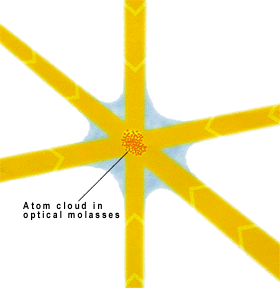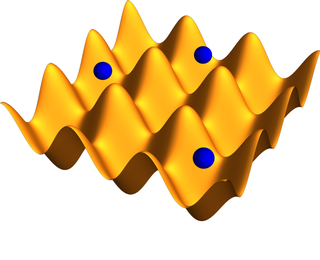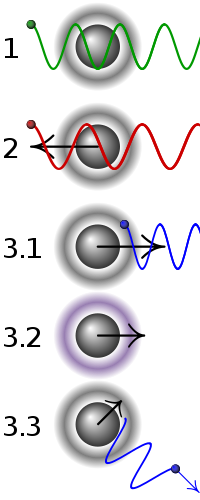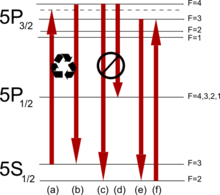
Antihydrogen is the antimatter counterpart of hydrogen. Whereas the common hydrogen atom is composed of an electron and proton, the antihydrogen atom is made up of a positron and antiproton. Scientists hope that studying antihydrogen may shed light on the question of why there is more matter than antimatter in the observable universe, known as the baryon asymmetry problem. Antihydrogen is produced artificially in particle accelerators.

Ionization is the process by which an atom or a molecule acquires a negative or positive charge by gaining or losing electrons, often in conjunction with other chemical changes. The resulting electrically charged atom or molecule is called an ion. Ionization can result from the loss of an electron after collisions with subatomic particles, collisions with other atoms, molecules and ions, or through the interaction with electromagnetic radiation. Heterolytic bond cleavage and heterolytic substitution reactions can result in the formation of ion pairs. Ionization can occur through radioactive decay by the internal conversion process, in which an excited nucleus transfers its energy to one of the inner-shell electrons causing it to be ejected.

Optical tweezers are scientific instruments that use a highly focused laser beam to hold and move microscopic and sub-microscopic objects like atoms, nanoparticles and droplets, in a manner similar to tweezers. If the object is held in air or vacuum without additional support, it can be called optical levitation.

Electromagnetically induced transparency (EIT) is a coherent optical nonlinearity which renders a medium transparent within a narrow spectral range around an absorption line. Extreme dispersion is also created within this transparency "window" which leads to "slow light", described below. It is in essence a quantum interference effect that permits the propagation of light through an otherwise opaque atomic medium.
In condensed matter physics and atomic physics, the recoil temperature is a fundamental lower limit of temperature attainable by some laser cooling schemes. It is the temperature corresponding to the kinetic energy imparted to an atom initially at rest by the spontaneous emission of a photon. The recoil temperature is

Optical molasses is a laser cooling technique that can cool neutral atoms to as low as a few microkelvin, depending on the atomic species. An optical molasses consists of 3 pairs of counter-propagating circularly polarized laser beams intersecting in the region where the atoms are present. The main difference between optical molasses and an MOT is the absence of magnetic field in the former. Therefore, unlike a MOT, an optical molasses provides only cooling and no trapping.
An atom laser is a coherent state of propagating atoms. They are created out of a Bose–Einstein condensate of atoms that are output coupled using various techniques. Much like an optical laser, an atom laser is a coherent beam that behaves like a wave. There has been some argument that the term "atom laser" is misleading. Indeed, "laser" stands for light amplification by stimulated emission of radiation which is not particularly related to the physical object called an atom laser, and perhaps describes more accurately the Bose–Einstein condensate (BEC). The terminology most widely used in the community today is to distinguish between the BEC, typically obtained by evaporation in a conservative trap, from the atom laser itself, which is a propagating atomic wave obtained by extraction from a previously realized BEC. Some ongoing experimental research tries to obtain directly an atom laser from a "hot" beam of atoms without making a trapped BEC first.

An optical lattice is formed by the interference of counter-propagating laser beams, creating a spatially periodic polarization pattern. The resulting periodic potential may trap neutral atoms via the Stark shift. Atoms are cooled and congregate at the potential extrema. The resulting arrangement of trapped atoms resembles a crystal lattice and can be used for quantum simulation.

Doppler cooling is a mechanism that can be used to trap and slow the motion of atoms to cool a substance. The term is sometimes used synonymously with laser cooling, though laser cooling includes other techniques.

In atomic, molecular, and optical physics, a magneto-optical trap (MOT) is an apparatus which uses laser cooling and a spatially-varying magnetic field to create a trap which can produce samples of cold, neutral atoms. Temperatures achieved in a MOT can be as low as several microkelvin, depending on the atomic species, which is two or three times below the photon recoil limit. However, for atoms with an unresolved hyperfine structure, such as 7Li, the temperature achieved in a MOT will be higher than the Doppler cooling limit.
Atom optics "refers to techniques to manipulate the trajectories and exploit the wave properties of neutral atoms". Typical experiments employ beams of cold, slowly moving neutral atoms, as a special case of a particle beam. Like an optical beam, the atomic beam may exhibit diffraction and interference, and can be focused with a Fresnel zone plate or a concave atomic mirror.
In condensed matter physics, an ultracold atom is an atom with a temperature near absolute zero. At such temperatures, an atom's quantum-mechanical properties become important.
David Edward Pritchard is a professor at the Massachusetts Institute of Technology (MIT), working on atomic physics and educational research.

A nuclear clock or nuclear optical clock is a notional clock that would use the frequency of a nuclear transition as its reference frequency, in the same manner as an atomic clock uses the frequency of an electronic transition in an atom's shell. Such a clock is expected to be more accurate than the best current atomic clocks by a factor of about 10, with an achievable accuracy approaching the 10−19 level. The only nuclear state suitable for the development of a nuclear clock using existing technology is thorium-229m, a nuclear isomer of thorium-229 and the lowest-energy nuclear isomer known. With an energy of 8.35574(3) eV, this corresponds to a wavelength of 148.3821(5) nm in the vacuum ultraviolet region, making it accessible to laser excitation. A comprehensive review can be found in reference.
In atomic physics, Raman cooling is a sub-recoil cooling technique that allows the cooling of atoms using optical methods below the limitations of Doppler cooling, Doppler cooling being limited by the recoil energy of a photon given to an atom. This scheme can be performed in simple optical molasses or in molasses where an optical lattice has been superimposed, which are called respectively free space Raman cooling and Raman sideband cooling. Both techniques make use of Raman scattering of laser light by the atoms.
A single-photon source is a light source that emits light as single particles or photons. Single-photon sources are distinct from coherent light sources (lasers) and thermal light sources such as incandescent light bulbs. The Heisenberg uncertainty principle dictates that a state with an exact number of photons of a single frequency cannot be created. However, Fock states can be studied for a system where the electric field amplitude is distributed over a narrow bandwidth. In this context, a single-photon source gives rise to an effectively one-photon number state.
Double ionization is a process of formation of doubly charged ions when laser radiation is exerted on neutral atoms or molecules. Double ionization is usually less probable than single-electron ionization. Two types of double ionization are distinguished: sequential and non-sequential.
Photonic molecules are a form of matter in which photons bind together to form "molecules". They were first predicted in 2007. Photonic molecules are formed when individual (massless) photons "interact with each other so strongly that they act as though they have mass". In an alternative definition, photons confined to two or more coupled optical cavities also reproduce the physics of interacting atomic energy levels, and have been termed as photonic molecules.
Sub-Doppler cooling is a class of laser cooling techniques that reduce the temperature of atoms and molecules below the Doppler cooling limit. In experiment implementation, Doppler cooling is limited by the broad natural linewidth of the lasers used in cooling. Regardless of the transition used, however, Doppler cooling processes have an intrinsic cooling limit that is characterized by the momentum recoil from the emission of a photon from the particle. This is called the recoil temperature and is usually far below the linewidth-based limit mentioned above.

Peter E. Toschek was a German experimental physicist who researched nuclear physics, quantum optics, and laser physics. He is known as a pioneer of laser spectroscopy and for the first demonstration of single trapped atoms (ions). He was a professor at Hamburg University.














